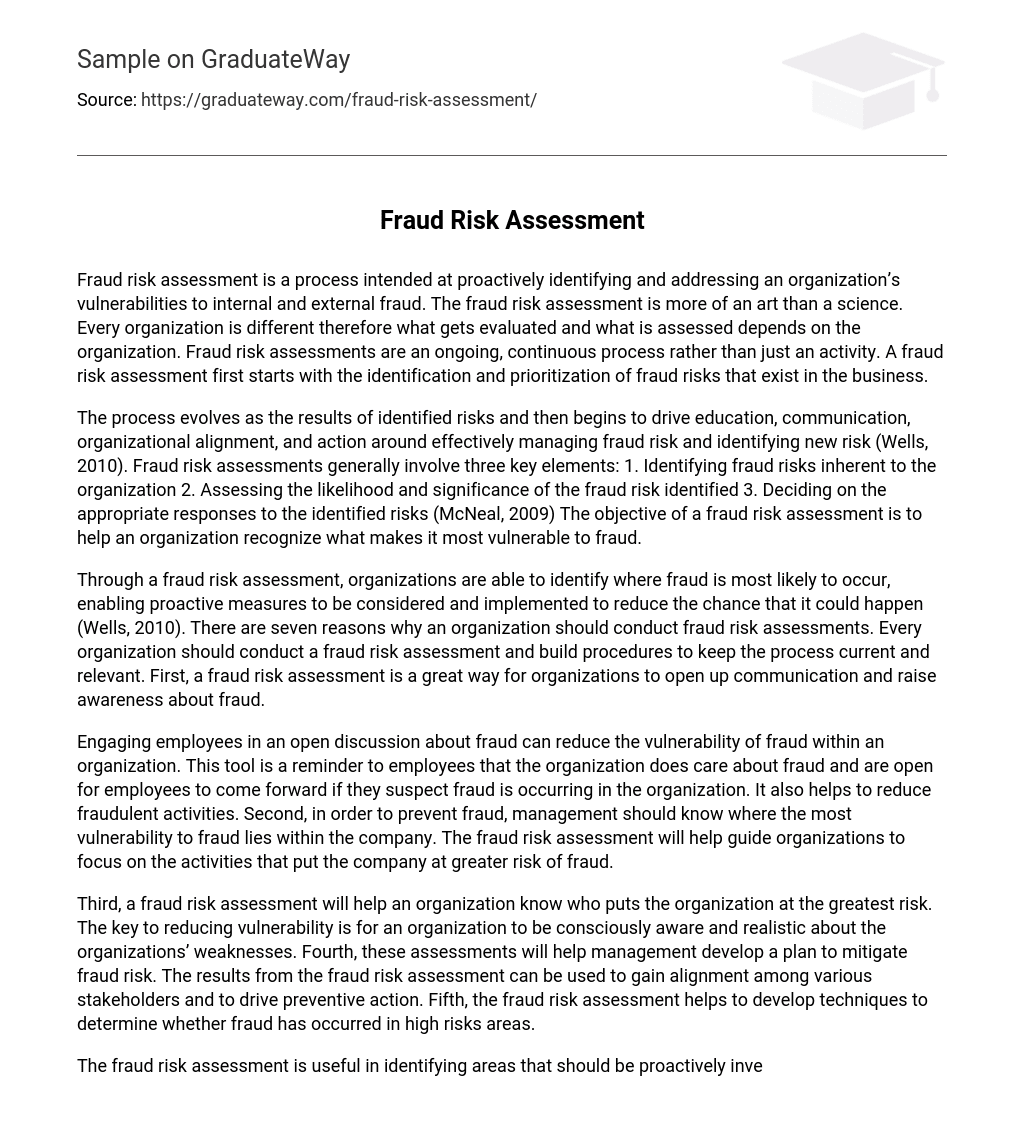Fraud risk assessment is a proactive process that aims to identify and address an organization’s vulnerabilities to internal and external fraud. It is a subjective task that varies depending on the unique characteristics of each organization. The assessment is an ongoing, continuous process and begins with identifying and prioritizing existing fraud risks in the business.
The text highlights that the process of managing fraud risk involves several key elements. It begins with identifying risks and using these results to drive education, communication, organizational alignment, and action. According to Wells (2010), this process also helps in identifying new risks. Additionally, fraud risk assessments typically involve three main elements: 1. Identifying fraud risks specific to the organization 2. Assessing the likelihood and significance of these identified risks 3. Determining appropriate responses to these risks (McNeal, 2009). The overall objective of a fraud risk assessment is to aid organizations in recognizing their most vulnerable areas in relation to fraud.
Fraud risk assessments enable organizations to pinpoint areas where fraud is most likely to occur, allowing them to take proactive steps to minimize the potential for fraud (Wells, 2010). Conducting fraud risk assessments is essential, as there are seven compelling reasons for organizations to do so. It is important for organizations to regularly update and maintain procedures associated with fraud risk assessments. By conducting these assessments, organizations create a platform for open communication and increased awareness about fraud.
Engaging employees in open dialogue about fraud is an effective way to reduce the organization’s vulnerability to fraudulent activities. By implementing this instrument, the organization emphasizes its commitment to addressing fraud and encourages employees to report any suspicions of fraudulent behavior. This approach also helps minimize instances of fraud. Furthermore, management should identify areas within the company that are particularly susceptible to fraud in order to prevent it effectively. The use of a fraud risk assessment enables organizations to focus on activities with a higher potential for fraudulent activity.
Thirdly, by conducting a fraud risk assessment, an organization can identify the individuals posing the highest risk to the organization. To minimize vulnerability, it is crucial for organizations to acknowledge and address their weaknesses realistically. Moreover, such assessments assist management in formulating a strategy to mitigate fraud risk. The outcomes of the assessment can be utilized to foster agreement among stakeholders and stimulate proactive measures. Additionally, the assessment aids in creating methodologies to ascertain instances of fraud in areas deemed high-risk.
The fraud risk assessment is helpful in identifying high-risk areas that should be proactively investigated for evidence of fraud. It also helps to determine which internal controls need to be followed. Conducting a fraud risk assessment allows management to assess the effectiveness of the company’s internal control system, considering factors such as eliminated controls due to restricting efforts, erosion of controls over time from business process reengineering, new collusion opportunities, lack of internal controls in vulnerable areas, nonperformance of control procedures, and inherent limitations of internal controls. Additionally, fraud risk assessments can assist management and auditors in meeting regulatory requirements and adhering to professional standards for fraud risk management. These seven steps explain the importance of using fraud risk assessments in any organization (Wells, 2010).
A successful fraud risk assessment aligns with the organization’s culture, is endorsed and backed by appropriate individuals, promotes open participation, and is embraced as a crucial and valuable procedure throughout the company. There are eight critical components to achieve a successful fraud risk assessment. Firstly, a collaborative approach involving both management and auditors enhances its effectiveness, as they jointly share responsibility and accountability for its achievements.
Moreover, it is crucial to have a sponsor who is receptive to receiving both positive and negative feedback as this significantly influences the efficacy of a fraud risk assessment. Furthermore, an efficient assessment can be conducted by either internal staff or by leveraging external resources. It is essential for those conducting and leading the assessment to uphold impartiality and objectivity in order to maintain its integrity. Lastly, individuals accountable for the assessment must possess a solid comprehension of the business.
The fraud risk assessor must possess a deep understanding of the business, including its purpose and operations. It is vital to include perspectives from individuals at all levels in the assessment process. Establishing trust between management, employees, and assessors is crucial to gain truthful insights into the business’s reality, culture, and susceptibility to fraud. The assessment should offer ample opportunities for thorough evaluation of fraud risk.
The process of assessing fraud risks should be continuous. This involves maintaining ongoing communication, actively managing action plans, and establishing procedures to keep the assessment current. By including these components in a company’s fraud risk assessment, it can effectively mitigate high fraud risks. Ultimately, a fraud risk assessment is an invaluable tool for identifying and addressing an organization’s susceptibility to fraudulent activities.
A successful fraud risk assessment is characterized by its alignment with the organization’s culture, sponsorship and support from relevant individuals, open participation from all members, and widespread recognition within the business as a valuable process. To be effective, the organization must fully embrace the findings of the assessment and use them to monitor and address factors that may pose a fraud risk (Wells, 2010).
Resource
The article titled “What’s Your Fraud IQ?” written by McNeal, Andi in 2009 can be found in the Journal of Accountancy. The full source of the article is retrieved from http://www.journalofaccountancy.com/Issues/2009/May/20091418.htm.
Wells, Joseph T. (2010). Principles of Fraud Examination. 3rd edition. John Wiley and Sons, Incorporated





